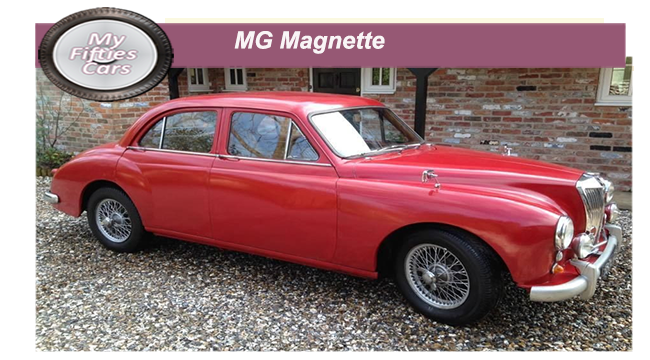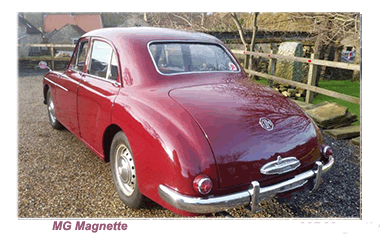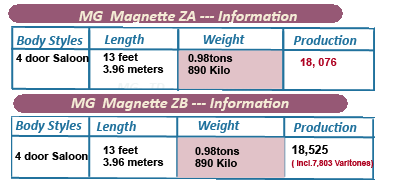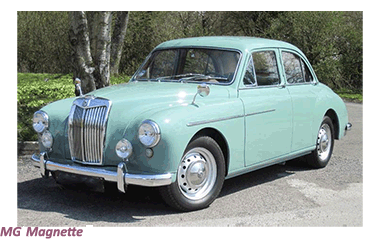>
Even though Morris Garages (MG) produced cars under the Magnette nameplate in the pre Second World War years, with the company focusing almost entirely on building sports cars, the brand lay dormant until the launch of the ZA series Magnette in 1954, nothing more or less than a four-door saloon.
 The Magnette ZA series, the first monocoque car to bear the MG badge, was a indeed a far cry from the MG- TDs and TFs that the company had built a strong reputation on,
The Magnette ZA series, the first monocoque car to bear the MG badge, was a indeed a far cry from the MG- TDs and TFs that the company had built a strong reputation on,
A direct replacement for the old YA/YB series, which had been in production, albeit in limited number even after the war, the MG Magnette was a complete departure from the direction that the company had been taking in the post-war years.
 In advertising media of the times, the Magnette is described as very first of the "BMC-MGs", as opposed to the `Nuffield-MGs" which had dominated the scene at the Abingdon factory since the mid-Thirties.
In advertising media of the times, the Magnette is described as very first of the "BMC-MGs", as opposed to the `Nuffield-MGs" which had dominated the scene at the Abingdon factory since the mid-Thirties.
The MG Magnette ZA was designed and engineered based on BMC’s Wolseley 4/44, which was released the previous year.
 The Magnette was conceived by the renowned Gerald Palmer, who had recently joined BMC after leaving Jowett, where he was responsible for developing the innovative Javelin.
The Magnette was conceived by the renowned Gerald Palmer, who had recently joined BMC after leaving Jowett, where he was responsible for developing the innovative Javelin.
This time around, evidence of Palmer’s expertise was more apparent in the technical aspects of the car, marked by the first appearance of BMC’s recently developed four-cylinder 1.5 L (1489 cc) B-Series I4 engine.
![]()
 The engine, fitted with twin 1¼ inch SU carburettors, was capable of delivering 60 bhp (45 kW) was coupled with BMC's new four-speed manual gearbox. The car also came with an innovative remote control centre gear change
The engine, fitted with twin 1¼ inch SU carburettors, was capable of delivering 60 bhp (45 kW) was coupled with BMC's new four-speed manual gearbox. The car also came with an innovative remote control centre gear change
 The Magnette’s steering was by rack and pinion., while it also boasted an independent suspension system, using coil springs on the front wheels and a live axle on the rear.
The Magnette’s steering was by rack and pinion., while it also boasted an independent suspension system, using coil springs on the front wheels and a live axle on the rear.
Hydraulically operated 10 inch (254 mm) drum brakes, supplied by Lockheed were fitted to front and rear.
The MG Magnette was a smart looking car, with a smart semi-fastback four-door monocoque structure, to which a curved version of the MG grille had been neatly blended.
 To add to the feeling of luxury for the interior, the Magnette’s dashboard and door caps were finished in polished wood.
To add to the feeling of luxury for the interior, the Magnette’s dashboard and door caps were finished in polished wood.
In 1956, MG replaced the Magnette ZA version with the ZB. Whilst looking exactly the same as the ZA, through fitting 1½ inch carburettors, power on the ZB was increased to 64 bhp (48 kW), increasing the car’s top speed to 86 mph (138 kmh).
MG also released a “Varitone” version of the Magnette, which featured a larger rear window as well as the option of some jazzy two-tone colour combinations in the paintwork.![]()

The two-tone concept caught on fairly well with the UK motoring public, who was looking for more glamour in their motor vehicles in the brighter and more optimistic times of the late Fifties.
Of the 18,500 ZB versions of the MG Magnette that were produced between 1956 and 1958, close to 8,000 of them were “Varitones”.
During the six years that it had been in production, MG turned out a total of 36,600 Magnettes.



